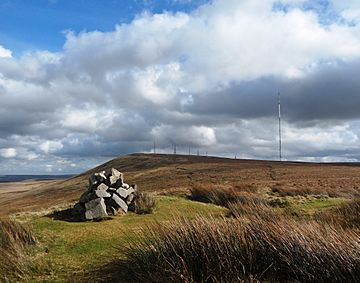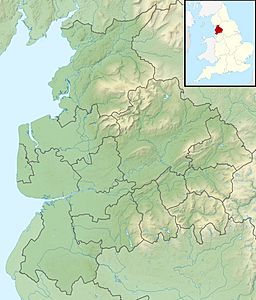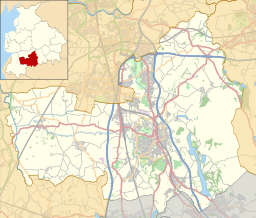Noon Hill (North West England) facts for kids
Quick facts for kids Noon Hill |
|
|---|---|

Tumulus and cairn on Noon Hill, with Winter Hill in the background
|
|
| Highest point | |
| Elevation | 380 m (1,250 ft) |
| Parent peak | Winter Hill |
| Listing | Marilyn |
| Geography | |
| Location | North West England |
| OS grid | SD647150 |
Noon Hill is a cool hill located in North West England. It sits right on the edge of three different areas: Chorley, Blackburn with Darwen, and Bolton. This hill is part of Rivington Moor in Chorley and stands about 380 meters (1,247 feet) tall.
Noon Hill is part of the West Pennine Moors, which is a popular place for walking and exploring. But it's not just a great spot for a hike; it's also super important because of its amazing history. At the very top of Noon Hill, you'll find an ancient burial mound from the Bronze Age. This special site is protected by law because it's considered nationally important!
Noon Hill's Ancient Burial Site
The burial mound on Noon Hill is sometimes called the Noon Hill Saucer Tumulus. It's one of two similar burial mounds in the area. The other one is about 1 kilometer (0.6 miles) to the east, near the top of Winter Hill. Experts believe this mound was built around 1100 BC, which means it's over 3,000 years old!
What Archaeologists Found
People have dug into the Noon Hill monument twice to learn more about it. The first time was in 1958. Then, in 1963 and 1964, the Bolton and District Archaeology Society (now called the Bolton Archaeology and Egyptology Society) did another excavation.
During these digs, archaeologists made some incredible discoveries. They found the cremated (burned) remains of three people! These remains belonged to an adult man, an adult woman, and a child. They were found carefully placed inside a stone box.
Besides these main burials, the archaeologists also found other cremated remains. Plus, they discovered some amazing tools made of flint stone. These included barbed and tanged arrowheads, tools for scraping, and even a special knife with a sharp edge. You can actually look at the old reports and photos from these excavations online at the BAES Archives.
Why Noon Hill is Important
Even though the monument was dug up in the 1950s and 1960s, the round stone mound on Noon Hill is still in pretty good shape. Archaeologists believe there might be even more burials hidden inside the mound. They also think there could be more ancient items still buried beneath the mound's surface. This makes Noon Hill a very special place for understanding how people lived and buried their dead thousands of years ago in England.



